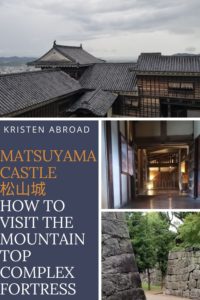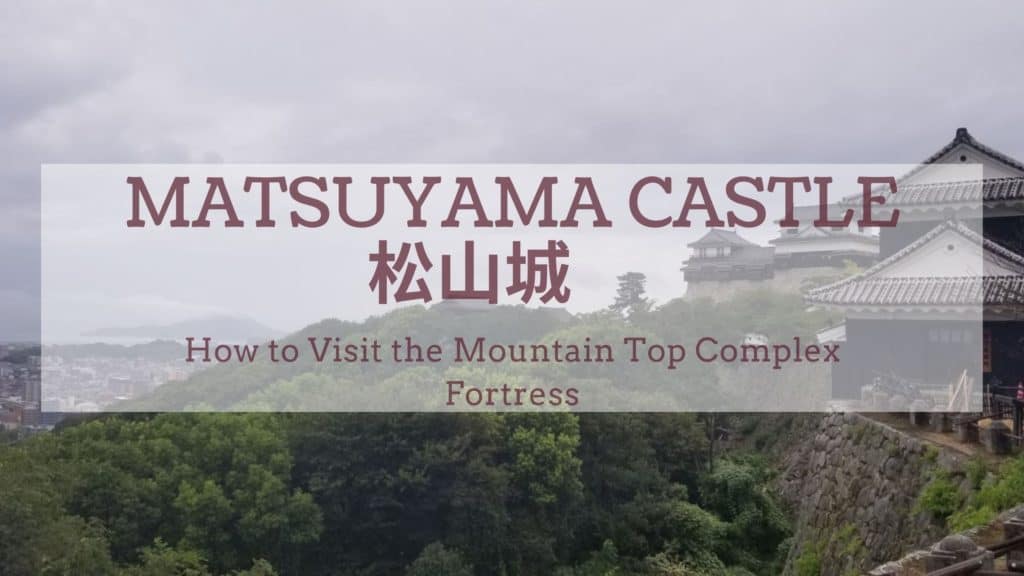Matsuyama Castle (松山城, Matsuyamajyou) is officially my favorite Japanese Castle. One of the original twelve Edo period castles remaining, first constructed in the 1600s. It is located on Shikoku, the smallest of Japan’s four islands in Ehime prefecture.
- What does it mean to be an “original 12” Edo Period Castle?
- Other Matsuyama Castles
- Matsuyama Castle: A castle on a hill
- Important Cultural Property
- Matsuyama Castle construction
- Ninomaru Historical Garden
- Is there a moat at Matsuyama Castle?
- Why is Matsuyama Castle my favorite Japanese castle?
- Getting to Matsuyama Castle
[Editor’s Note: This post was originally published in September of 2018 and has been updated for freshness, accuracy, and comprehensiveness.]
Disclosure: Kristenabroad.com is a participant in the Amazon Services LLC Associates Program and other affiliate programs. For some links to products or services in this article, I may earn a small commission by you using my link. The price for you is not affected.
What does it mean to be an “original 12” Edo Period Castle?
There are 12 castles in Japan that are considered “original castles”. While there are bits and pieces of many of the estimated thousands of castles in Japan, and lots of reconstruction, the originals “made it out alive” so to speak. When the Meiji Restoration took hold in the 1860s, the castles were ordered to be dismantled. Want to unite a country under one central government? Take out all of the seats of power of the old system. Only the 12 were allowed to remain.
The castle keep while construction started early in the 1600s like most of the other castles, was completed in 1635 (my thoughts on why that was in a bit). It was struck by lightning in the late 1700s burning it to the ground, as wood structures are ought to do. The main keep was then rebuilt and finished in 1854. Just in the knick of time to have it all threatened to be torn down again!
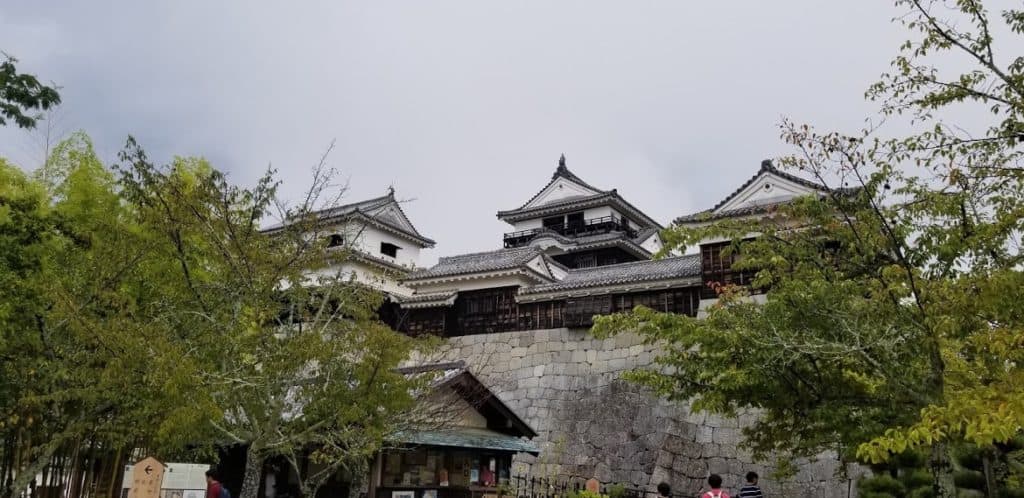
Other Matsuyama Castles
When searching for details (though I hope I give you a good overview here!), make sure to look up the correct Matsuyama Castle. There are several others.
Next to the rather unique Yoshimi Hundred Caves in Saitama Prefecture s the castle remains of a different Matsuyama Castle. It holds the title of a historic site and is actually the location of several differently named castles over the years. What remains is just earthworks but it’s a fun little hike.
Another of the 12 original (現存12天守) is Bitchu-Matsuyama Castle in Okayama Prefecture has “Bitchu” on the front to distinguish it from Matsuyama Castle in Ehime. Bitchu is the city name, it also holds the title of highest of the 12 original castles.
Then two others I haven’t been to yet, Uda Matsuyama Castle in Nara Prefecture is only ruins remaining but part of the continuing 100 castle stamp quest. Another is in Gunma Prefecture.
Why so many castles with the same name? 松山 = Pine Mountain.
Matsuyama Castle: A castle on a hill
The honmaru (literally, “first circle” and corresponds to defense rings, normally translated as bailey) main keep of the castle sits on a 132-meter hill. With the maze of paths to get to the top, I’d have died 50 times over if I tried to get in. Multitudes of gates, giant reinforced walls, all sorts of ways to keep people out.
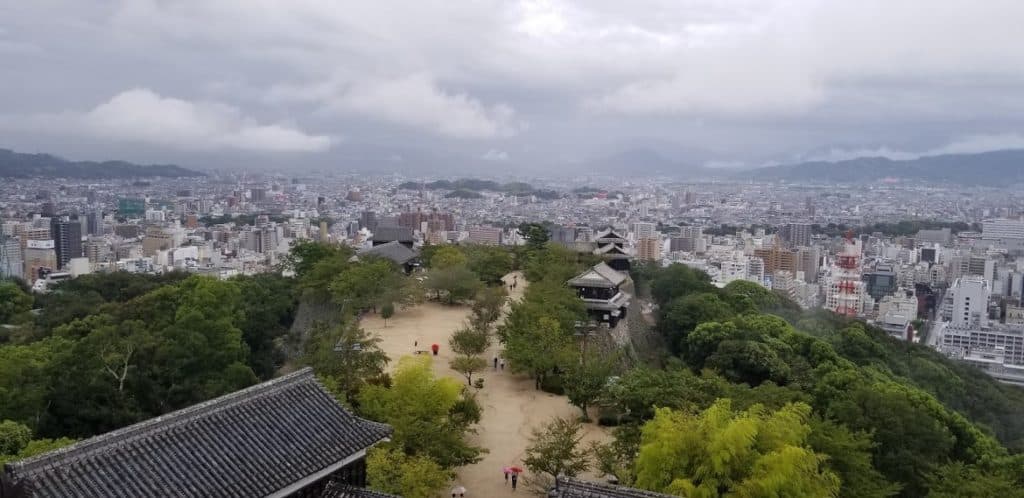
I wish I had gotten video of me “scaling” the castle as I’m sure it was a sight to see. You can truly feel like you are back in the 1600s with a samurai hiding around any corner while you are walking here. Matsuyama Castle matches Hikone Castle in that it has 登り石垣 or climbing stone walls, a style that is thought to have been learned from the Koreans (if you’ve been to Seoul, you’ve seen something similar).
Once you reach the top, there are amazing panoramas of the surrounding city and a great view of the Seto Inland Sea. But wait until you get to the main castle keep, it’s awe-inspiring. You really get a feel for what a castle is supposed to be in its full glory. Its style is unique to most other castles in which it has a sort of courtyard in the middle. Better to shoot the enemy at if they somehow managed to make it all the way here.
Speaking of, the castle keep was only really used in a siege scenario, the lord would have spent most of their time at the palace below.
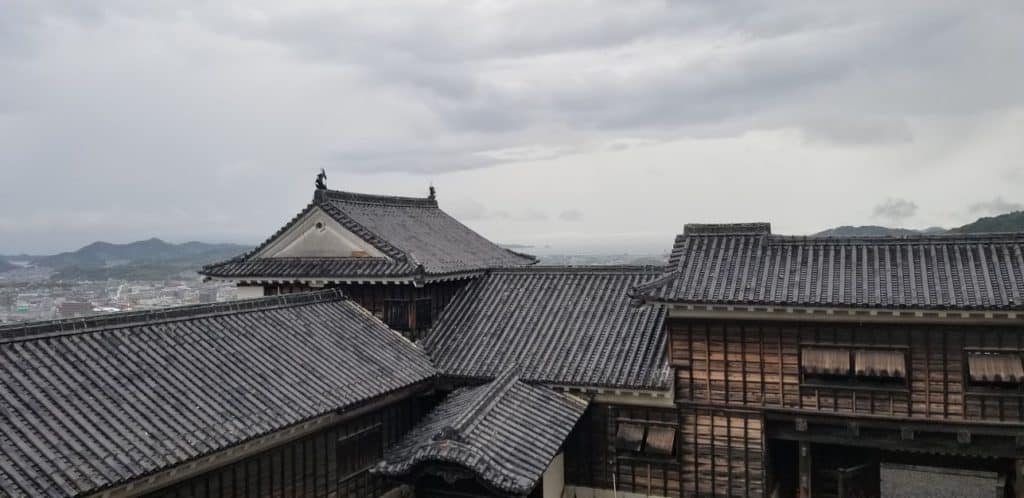
Important Cultural Property
Matsuyama Castle obtained Important Cultural Property status in 1935. There are only five of the “original” castles that have “National Treasure” status but many with Important Cultural Property including some rebuilds, like Nagoya Castle and its palace (which unlike Kawagoe’s, has had extensive work done to it). Though honestly, it is interesting to me that Matsuyama is NOT a National Treasure, but I’m biased.
The main tower (tenshu) is what makes it “one of the 12” original castles. but it’s not the only important cultural property. There are 21 buildings in total that are important cultural properties at Matsuyama Castle.
- 天守, tenshu, main tower
- 三ノ門南櫓, Sannomon South Tower
- 二ノ門南櫓, Ninomon South Tower
- 一ノ門南櫓, Ichinomon South Tower
- 乾櫓, Inui Tower
- 野原櫓, Nohara Tower
- 仕切門, Partition Gate
- 三ノ門, Sannomon
- 二ノ門, Ninomon
- 一ノ門, Ichinomon
- 紫竹門, Shichiku (Bamboo) mon
- 隠門, Kakure (Hidden) Gate
- 隠門続櫓, Kakure (Hidden) Gate Turret
- 戸無門, Tonashi (Doorless) Gate
- 仕切門内塀, Partition Gate Inner Wall
- 三ノ門東塀, Sannomon East Wall
- 筋鉄門東塀, Tetsumon East Wall
- 二ノ門東塀, Ninomon East Wall
- 一ノ門東塀, Ichinomon East Wall
- 紫竹門東塀, Shichikumon East Wall
- 紫竹門西塀, Shichikumon West Wall
Matsuyama Castle construction
You may have noticed in the pictures a rather flat area at the top of the hill (yes, it’s a “mountain” but not a very big one). Actually, that 132-meter hill used to be TWO hills at the top, but they filled in the gap between them, talk about a lot of work and why I think it took so long to make, though I haven’t seen anything that actually says that.
One question I had when I saw that little factoid, was where did all the stone come from? Can you imagine the amount of work that took? There was a note on the visitor brochure that women carried pebbles on baskets on their heads from Masaki to Matsuyama. That’s over SIX miles! Most of the larger stone came from an earlier castle’s foundation. Victors prize and a lot easier than moving large distances.
The inside of the castle has some museum aspects to it, like a neat display on the joiner work for all of the wood to make it stronger, but the main sight is to see this castle in its glory.
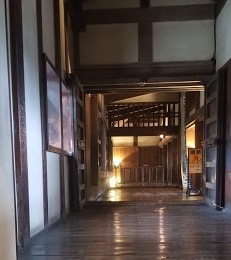
Ninomaru Historical Garden
Not to be missed is this Japanese Garden in the Ninomaru, or second circle/ bailey. Where once stood a giant palace, now the foundation outlines a garden. The flowers are changing throughout the year to give you another reason to keep coming back as if you will need one after seeing this place.
If you needed another thing to check off your list, there is a “Lover’s Sanctuary” spot here like the one in Ryusendo Caves. There are over 100 around the country to find!
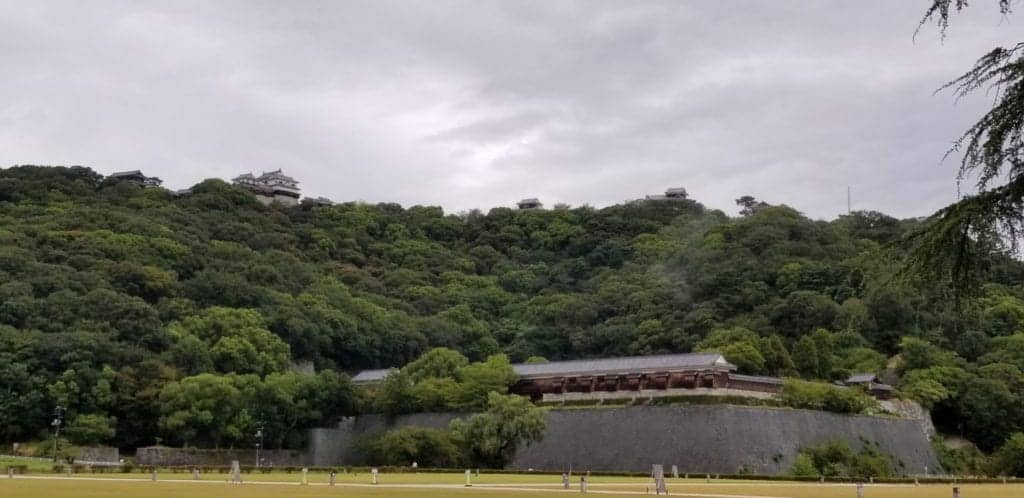
Is there a moat at Matsuyama Castle?
The flat land park that you will pass on your way from the train station known as Horinouchi is surrounded by a moat to this day. It makes for some nice pictures looking at the mountain fortress.
Why is Matsuyama Castle my favorite Japanese castle?
Matsuyama Castles has a certain character to it that I haven’t seen anywhere else. Generally speaking, the keeps are all multi-floor structures (that don’t always match their exterior tiers), but Matsuyama has wings which are fairly uncommon in Japanese keeps. Next to Himeji Castle, it has the most complete representation of probably any in Japan which gives you a better feel for what it was actually like. And yes, Himeji is AMAZING, but Matsuyama just has a certain character about it.
It’s also one of the 100 finest castles of Japan so don’t forget your stamp!
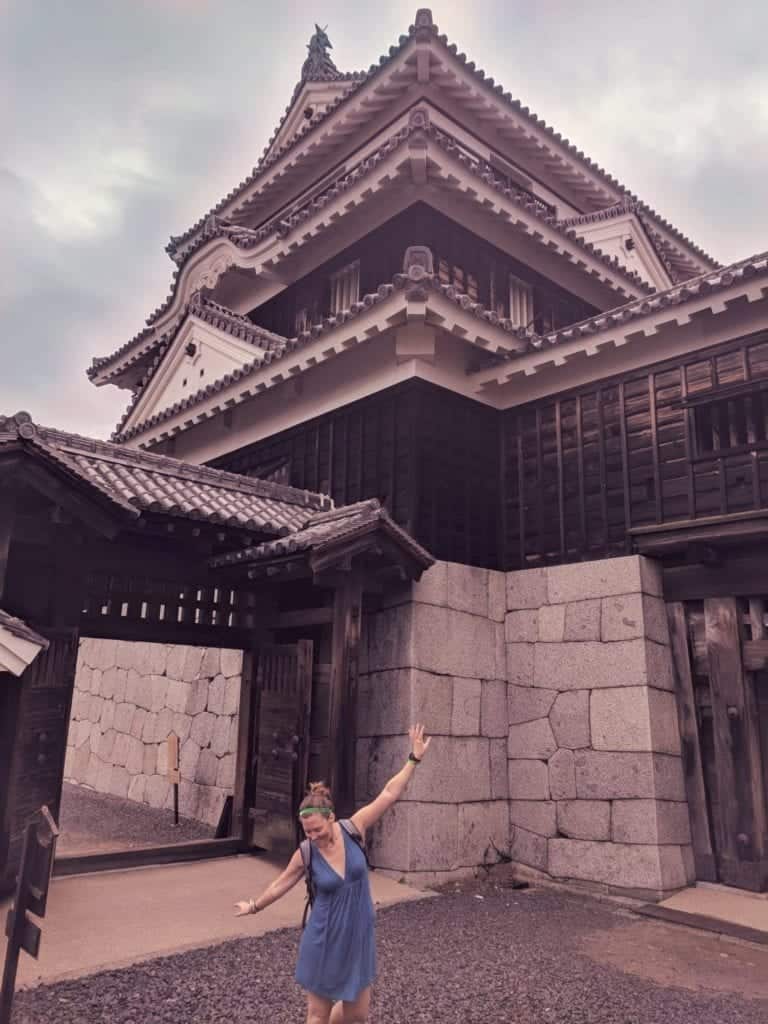
Getting to Matsuyama Castle
If you aren’t keen on hiking the 132-meter hill (though if you are, there are several hiking courses to get your steps in, which I love tracking with my Garmin Fenix 6S), you can take a ropeway to the top. Similar to a ramen shop, you’ll get your tickets from a machine. If you have luggage with you, they have coin lockers for you to use.
Think of the ropeway as a gondola like you take getting to the black eggs at Owakudani in Hakone. Want something a little more “open-aired”? They also have a ski lift version that runs next to the ropeway with single seats.
In the station building, there is a display dedicated to the castle mascot. Japan loves their mascots and you could make a game of finding as many as you can. Matsuyama Castle’s is appropriately a samurai.
You’ll still have a bit of a walk to the castle keep from the ropeway landing. If you take the ropeway up, I suggest you take the hike back down the mountain. It’s worth it to see all the back and forth of the many defenses at this castle’s disposal. It’s also how you can get to Ninomaru Historical Gardens.
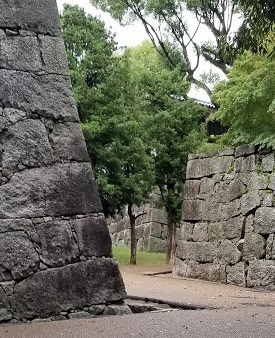
It’s about a mile from the main train station in Matsuyama to get to the castle or you can take a trolley. My suggestion would be to either go trolley (unless you need some more steps!) – ropeway – main keep – ninomaru gardens and walk back or that in reverse.
